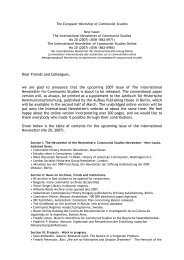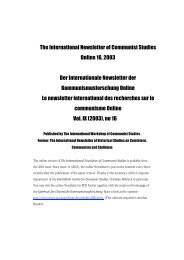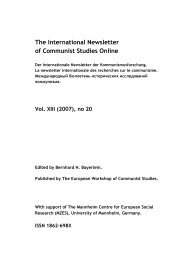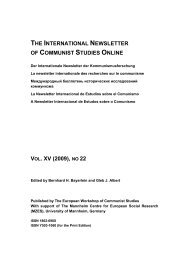VOL. XVI (2010), NO 23 - The International Newsletter of Communist ...
VOL. XVI (2010), NO 23 - The International Newsletter of Communist ...
VOL. XVI (2010), NO 23 - The International Newsletter of Communist ...
Erfolgreiche ePaper selbst erstellen
Machen Sie aus Ihren PDF Publikationen ein blätterbares Flipbook mit unserer einzigartigen Google optimierten e-Paper Software.
<strong>The</strong> <strong>International</strong> <strong>Newsletter</strong> <strong>of</strong> <strong>Communist</strong> Studies Online <strong>XVI</strong> (<strong>2010</strong>), no. <strong>23</strong> 85<br />
<strong>The</strong> foundation process <strong>of</strong> the Spanish <strong>Communist</strong> Party had started before 1921. As Phillips<br />
wrote several decades later in his memoirs, at Borodin's insistence, “the group undertook to<br />
break in time to be represented at the approaching Second Congress in Moscow”. 26 <strong>The</strong><br />
“Provisional Committee for the Third <strong>International</strong>” was created with the participation <strong>of</strong> some<br />
PSOE militants, Borodin and “Ramírez”, and the new structure started negotiations with the<br />
left wingers aiming to affiliate the party or a fraction with Moscow. <strong>The</strong> main basis for such an<br />
activity was the Socialist Youth Federation which had declared its immediate and<br />
unconditional alignment with the Comintern.<br />
<strong>The</strong> Spanish adherents <strong>of</strong> the 3 rd <strong>International</strong> faced a dilemma – either to develop the left<br />
wing within the PSOE and later conquer the leadership and to convert the party into a<br />
communist one, or to split it with the aim <strong>of</strong> creating a <strong>Communist</strong> organization. 27 “Ramírez”,<br />
who was left by Borodin in Madrid as his plenipotentiary representative, rather opted for the<br />
first way. But, as the Comintern adepts met with the reluctance <strong>of</strong> the main part <strong>of</strong> the<br />
socialists to become communists, they spitted the PSOE and founded the <strong>Communist</strong> Party<br />
<strong>of</strong> Spain on the basis <strong>of</strong> the Socialist Youth Federation in April 15, 1920, which later joined<br />
the Comintern. Doubtlessly this did not happen due to the status <strong>of</strong> Borodin as Comintern<br />
representative (as we know, the alias “Borodin” was used for the first time in Spain), but<br />
thanks to the personality <strong>of</strong> this <strong>Communist</strong> emissary, his knowledge, vast energy and<br />
capacity to convince different people. He really managed to make an impression on the<br />
Spaniards so greedy for emotions.<br />
In the second half <strong>of</strong> January, 1920, Borodin left Spain for the Dutch capital where the<br />
Amsterdam bureau <strong>of</strong> the Comintern had been established by Sebald Justinus Rutgers. <strong>The</strong><br />
bureau was preparing an international conference, had developed propaganda in favour <strong>of</strong><br />
Bolsheviks and Soviet Russia, and was looking for adherents <strong>of</strong> the 3 rd <strong>International</strong> in<br />
different countries. <strong>The</strong> Spanish issues were discussed several times in conversations<br />
between Borodin and the Bureau members such as Rutgers, Henriette Roland Holst, David<br />
Wynkoop and others. <strong>The</strong> Comintern emissary insisted on the necessity to cooperate with<br />
the Partido Comunista Mexicano and the left wing <strong>of</strong> the PSOE in order “to maintain relations<br />
with Spain and through Spain with Mexico and the Pan American Bureau [the reference is<br />
made to the Latin American Bureau <strong>of</strong> the 3 rd <strong>International</strong>] for the purpose <strong>of</strong> distributing<br />
news and information and forming a connecting link between Russia and these countries.”<br />
Furthermore, “[t]hey are to receive our Bulletin28 and the news items from our Press-bureau<br />
and to give in exchange new pertaining to their countries[,] […] to support and maintain the<br />
paper El Soviet29 and also it would be desirable to start a communist weekly in Spain.” 30<br />
However, given the dissolution <strong>of</strong> the Amsterdam bureau by the Comintern leadership by<br />
spring <strong>of</strong> 1920, the Spanish question was “suspended” and transferred to Moscow in order to<br />
achieve a decision.<br />
However, it was the 3 rd <strong>International</strong> that decided to bring the rapidly developing Spanish<br />
affairs to a halt for some time. On the one hand, Charles Phillips, who arrived at the<br />
Comintern’s 2 nd World Congress under the new pseudonym "Frank Seaman", entered into a<br />
narrow circle <strong>of</strong> international <strong>Communist</strong> functionaries and got acquainted with the leaders <strong>of</strong><br />
26 Charles Shipman: It Had to Be a Revolution. Memoirs <strong>of</strong> an American Radical, Ithaca, Cornell University Press,<br />
1992, pp. 93-95.<br />
27 Rapport sur l’origine et fondation du Parti <strong>Communist</strong>e Espagnol presenté par le secretaire de ce parti camarade<br />
R. Merino Gracia au bureau de la III <strong>International</strong>e <strong>Communist</strong>e. RGASPI, 495/120/204, 56-59a.<br />
28 <strong>The</strong> Bulletin issued by the Amsterdam Bureau.<br />
29 rd<br />
El Soviet was the newspaper published by the PCM and the Latin American Bureau <strong>of</strong> the 3 <strong>International</strong> in<br />
Mexico.<br />
30 G.L. Trotter to Borodin, February 15, 1920. RGASPI, 497/2/1, 12-12ob.














